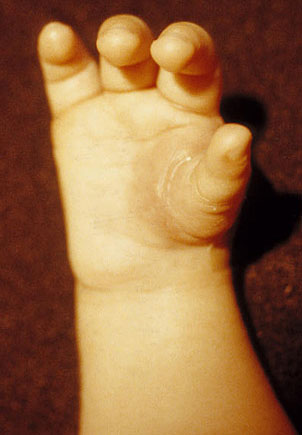Pollicization

What is Pollicization?
Pollicization is characterized by the substitution of a functioning finger for a deficient thumb.
Pollicization substitutes a functioning finger for a deficient thumb. Pollicization is a reconstructive surgery in which the index finger is migrated to the position of a thumb.
Primarily used for infants and other patients who were born without a thumb or have lost it in injury, pollicization entails shifting the index finger and rotating it to the thumb’s usual orientation while leaving its arteries and veins attached. Then, the finger is connected to the tendons that are left over from the previous thumb, or substituting those of the index finger, to improve the function of the thumb.
Anatomy of the Thumb
The thumb’s arterial supply is provided by the terminal branch of the radial artery, the princeps pollicis. This artery crosses the first intermetacarpal space to run on the volar aspect of the MCP joint, where it divides into the ulnar and radial collateral arteries.
The median nerve and the superficial radial nerve supply sensation to the palmar skin and to the dorsal side of the thumb, respectively.
Indications for Pollicization
Restoration has 5 primary components of thumb function — stability, strength, mobility, sensibility, and posture. This should serve as the basis for any reconstructive plan.
Consideration of these components and how they relate to each other allows a functional approach to the thumb deficit that guides the reconstructive hand surgeon.
The goals of thumb reconstruction consist of the following:
- Sensate a thumb tip
- Stabilize the interphalangeal (IP) and metacarpophalangeal (MCP) joints
- Provide strength
- Correct posture and positioning of the thumb
Optimal function is the ultimate goal of surgical intervention, which includes giving patients the ability to perform movements requiring pinching, fine manipulation, and power grip.
Other cases for pollicization include:
- When the hand has five fingers, but the radial-most finger is not a thumb.
- Floating thumb: a congenital defect where a patient has a hypoplastic thumb without its metacarpal bone or muscles.
Surgical Therapy
The goal of surgical intervention is to try and improve the function of the thumb and to provide with an aesthetically pleasing result to the hand. The level of amputation determines the reconstruction plan.
The outcome for surgical intervention favors reconstruction where an amputation has occurred to the distal MCP joint and therefore leaves the first web space intact.
During surgical intervention, the index finger metacarpal bone is cut and rotated approximately 120 to 160 degrees. It is then replaced at the base of the hand at the usual position of the thumb. The arteries and veins are left attached. If nerves and tendons are available from a previous thumb, they are attached to provide the sensation and movement to the new thumb.
Outcome and Prognosis
Surgical intervention involving toe-to-hand procedures has a history of excellent results with a high degree of patient satisfaction. The resulting survival rate of these transfers is reportedly as high as 98%. Reported grip strength is equal to 80% of the non-injured hand’s grip strength in addition to a 2 point discrimination of 8mm or less in most cases.
Most patients who have undergone toe-to-thumb transfer return to work and resume previous leisure activities with a high degree of function and patient satisfaction.
If You Believe You Need Reconstruction Surgery, Contact HandSport Surgery Institute
Please contact us as soon as possible to schedule an appointment with our talented team. People who may require pollicization should be evaluated to find the best treatment option possible.
If you have been injured, it’s important to be evaluated by a highly skilled professional. Call Dr. Mark Pruzansky and Dr. Jason Pruzansky at 212-249-8700 to schedule an appointment, obtain an accurate diagnosis, and start to improve the function of your arm.



